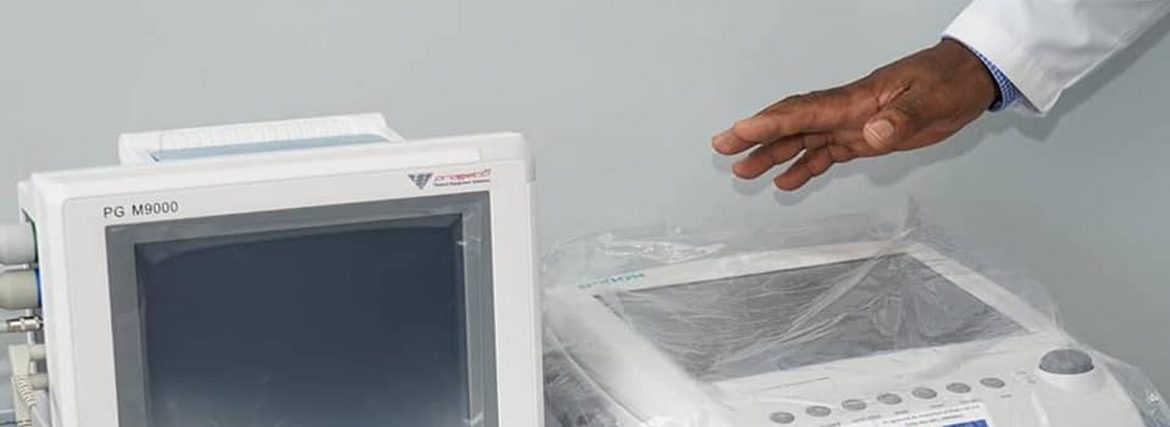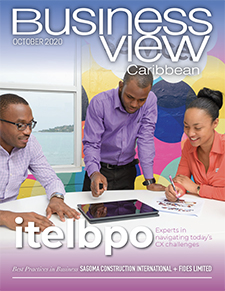North East Regional Health Authority (NERHA)
The best in community care
Business View Caribbean interviews Fabia Lamm, CEO of the North East Regional Health Authority, for our focus on healthcare in Jamaica.
The North-East Regional Health Authority (NERHA) was established out of the National Health Service Act in 1997 and the Government of Jamaica’s Health Reform Program which decentralized health service delivery. At that time, management of the delivery of health services shifted from central government and the Ministry of Health to four semi-autonomous Regional Health Authorities (RHA). Today, those RHAs are responsible for the operation and management of health services within a defined geographic area.
Within the purview of North-East Regional Health Authority, this means overseeing the management of secondary health care delivery throughout three parishes, at St. Ann’s Bay Regional Hospital, Port Maria and Annotto Bay Hospitals in St. Mary, and the Port Antonio Hospital in Portland, as well as 72 health centers (primary care), two of which were community hospitals (Alexandria and Buff Bay).
Business View Caribbean recently spoke with CEO & Regional Director of NERHA, Miss Fabia Lamm, who offered candid insights into how NERHA is helping the region deal with the coronavirus pandemic, and updates on planned infrastructure projects designed to enhance technology and service offerings. The following is an edited transcript of that conversation.
BVC: How is NERHA assisting communities during the coronavirus pandemic?
Lamm: “We currently have about 2,800 staff members. Since the onset of COVID-19, we received permission to employ additional medical officers and a category of workers we call Community Health Aides. The objective is to get more reach at the community level by employing persons who live within particular communities to assist with the COVID outreach. So, people are interacting with someone they know and trust.
“Community Health Aides assist with public health education and assist the public health nurses and inspectors with contact tracing. Jamaica is now in the classification of community spread for COVID-19, which means persons are contracting the disease but you’re no longer able to connect them to travel or any particular individual. It makes contact tracing more difficult and so the strategy now is to do community outreach, heightened surveillance and education, reminding people about how the disease can be spread, maintaining six feet social distancing, wearing masks, sanitizing. Our team also distributes masks and sanitizers and educate persons on the need to be responsible in how they move around.
“Currently, our Disaster Risk Management Act requires that any individual 70 years and over needs to be staying home, and that changes the dynamic because in our culture you’ll find multigenerational persons living in one household. The elderly are living among the young, so in our efforts to restrict the numbers of elderly who are affected, you need to be able to sensitize the younger persons that their activities outside the household can affect their elderly loved ones.”
BVC: Is outreach more difficult in some communities than others?
Lamm: “There are different socio-economic levels and the rate that persons move around depends on the needs they have. Some need to be out to make a living. Since the onset of COVID, especially in this region, it is difficult because Jamaica is tourism-dependent; it is our number-one foreign exchange earner, more specifically, along the north coast belt. And the three parishes that are part of NERHA are all along the north coast belt where persons predominately work within the tourism sector, working on cruise lines, or in farming – as part of the Farm Work Program where they work on farms overseas to make a living. And now the ability to travel has been seriously restricted.
“So, in this region, persons are at a distinct disadvantage due to loss of income. It also affects our health care workers because in almost every household of our employees, someone has been disenfranchised by virtue of losing their job in the tourism sector, whether directly or indirectly, or their hours have been significantly cut.”
BVC: What resources are available to help health care workers cope with the mental health aspects of being on the front lines?
Lamm: “We have to take care of ourselves before we can help others, and so the Ministry of Health and Wellness has launched the Staff Welfare Program across the health sector. It is geared at ensuring that we pay particular attention to our own staff, so they can go out and sensitize other persons. The program is very detailed: it includes providing psychosocial support for health care workers dealing with depression as they go through changes within their households and personal changes in dealing with COVID.
“People call it ‘the new norm’ but it’s a whole different dynamic that we all have to learn to deal with. Mental health has come to the forefront with all of the uncertainty and the risk of exposure by virtue of doing your job. As part of the Staff Welfare Program, we will know which of our health care workers are isolated or in quarantine at home, and determine what kind of support we can give. While they are quarantined, they continue to receive their basic salary and benefits, which is good, but other allowances such as overtime and session allowances would no longer be payable. And if that household already has a member who has lost a job because of a workplace closing down or cutting hours, then it is even more trying for the worker to balance the scales.
“As part of the Welfare Program each parish across the island has dedicated testing sites with priority testing for health care workers and all other essential workers on the front line, where the results are back within 48 hours. That’s part of the strategy to ease the level of stress that our health care workers are experiencing.”
BVC: Is the private sector assisting, as well?
Lamm: “Yes, we still have assistance from the private sector – corporate Jamaica – where they donate ‘care packages’ for the front line staff, which include food items, toiletries, personal care items, fresh produce – just something to say ‘thank you.’ That has been one of the highlights of how the private sector has been reaching out.
 “I remember our first case of COVID-19 in Jamaica was on the 10th of March. We all had to be out there working while this disease had come, and the private restaurants would bring food and bottled water to the healthcare workers, so they were refreshed. And that continues, today. Now it’s just trying to get everyone to recognize our individual responsibilities to help each other. Because that’s how we’ll get through this until a vaccine has been approved.”
“I remember our first case of COVID-19 in Jamaica was on the 10th of March. We all had to be out there working while this disease had come, and the private restaurants would bring food and bottled water to the healthcare workers, so they were refreshed. And that continues, today. Now it’s just trying to get everyone to recognize our individual responsibilities to help each other. Because that’s how we’ll get through this until a vaccine has been approved.”
BVC: What infrastructure projects are underway to improve your facilities?
Lamm: “Through the IDB (Inter-American Development Bank), the Government of Jamaica, there is a loan/grant facility as part of an intervention for upgrades at St. Ann’s Bay Regional Hospital. It will be a phased project and we are now working on finalizing the design. The first phase will be a new Outpatients Department, Electronic Medical Records Department and enhancements to the Diagnostic Center in the radiology department to facilitate the addition of new X-ray machines and a CT scan machine. The first phase will also see us having an intensive care unit, which we’ve never had. So, we’ll be able to provide ICU beds and service for people in need. And we’ll be introducing nephrology services (renal care) in the region through that intervention. We’re expecting to see the infrastructure and construction work completed at St. Ann’s Bay Hospital in the next five years.
“Under that same IDB/GOJ initiative, we will also see the construction and equipping of a new district health center for the Ocho Rios community. It will be built in a space more conducive to client care than the current facility, which is no longer in an ideal location with the build-out of Ocho Rios and is underserving the needs of the community. Another new district health center will also be built in the Brown’s Town District. Additionally, the St Ann’s Bay Health Centre will be upgraded to a Comprehensive Health Centre, which will see an expansion of the services given at the primary care level. These projects are all in the design phase.
“Outside of the IDB intervention, through the Ministry of Health & Wellness, and the National Health Fund, we’re also building a new district health center in the Buff Bay community of Portland. Construction started on that 13-month project in July and is going well. And in St. Mary at the Annotto Bay Hospital, we are building a new laboratory department, which will have a blood bank and will expand services to include physiotherapy. Construction started on that 13-month contract in July, as well. Also, at Annotta Bay Hospital, with the onset of COVID, we renovated an existing building and created a four-bed isolation unit for persons who may need elevated services for any contagious disease that would need isolation. It’s fully equipped with ventilators and other critical equipment.
“The need to embrace technology is increasingly important. We are improving our technology in terms of Telehealth, Telemedicine, and moving our health records from paper-based to electronic. In St. Ann’s Bay Hospital, Annotto Hospital, and Port Antonio Hospital, the Xray system is now fully digitized, so a physician can log in online to see results without waiting for a film to be processed. And all of our meetings are virtual on digital platforms. It’s a quick learning curve but our team here has been adapting to best serve the public – while we take care of ourselves.”
BVC: Is there anything else you’d like to share?
Lamm: “On behalf of the Ministry of Health & Wellness, and my own Board of Management, I want to say ‘Thank You’ to all the staff within the North-East Regional Health Authority. This is a true work in progress that requires the effort and dedication of the team, and that has been forthcoming. It’s very good when you have a lot of work to do and everybody is working in tandem to get it done properly. And that’s really what we are seeing now.
 “This pandemic has taught us, too, that despite the fact that we have four regional health authorities in Jamaica, we have been working as one health system. Now more than ever, we’re working as one unified Ministry of Health and Wellness; each region helping the others with resources and that has really helped. I want to commend all the healthcare workers in Jamaica, and especially those in NERHA for stepping forward and doing what needs to be done.”
“This pandemic has taught us, too, that despite the fact that we have four regional health authorities in Jamaica, we have been working as one health system. Now more than ever, we’re working as one unified Ministry of Health and Wellness; each region helping the others with resources and that has really helped. I want to commend all the healthcare workers in Jamaica, and especially those in NERHA for stepping forward and doing what needs to be done.”
AT A GLANCE
North East Regional Health Authority
What: A regional health authority in Jamaica
Where: Ocho Rios, Jamaica
Website: www.nerha.gov.jm
PREFERRED VENDORS
Scientific and Medical Supplies Ltd. – www.sms-jamaica.com





 This information will never be shared to third parties
This information will never be shared to third parties